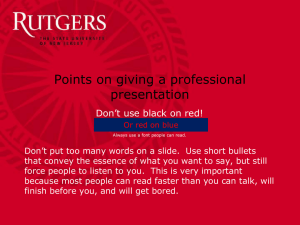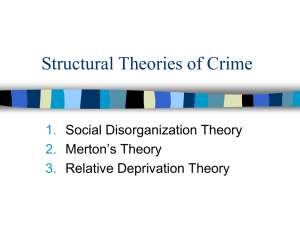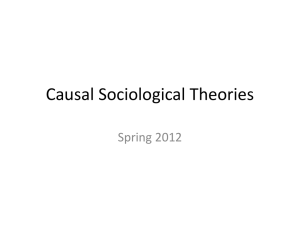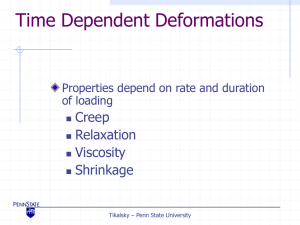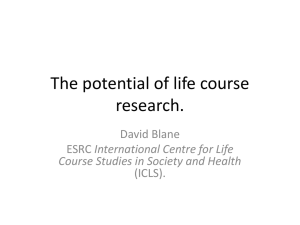Strain Theories continued
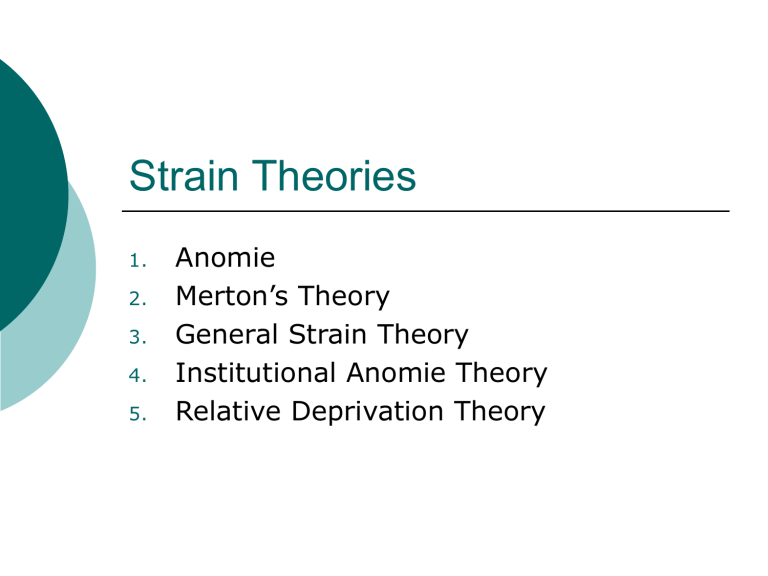
Strain Theories
1.
2.
3.
4.
5.
Anomie
Merton’s Theory
General Strain Theory
Institutional Anomie Theory
Relative Deprivation Theory
Strain Theory: R.K.Merton.
Merton used Durkheim's idea about anomie
Anomie is the state of normlessness
Rules of behaviour have broken down
Rapid social change
Personal life crisis
Egoistic, altruistic, and anomic suicide
Egoisitic suicide
Egoisitic suicide resulted from too little social integration
Durkheim discovered was that of unmarried people, particularly males, committed suicide at higher rates than married people
Altruistic suicide
Altruistic suicide, is a result of too much integration
Individuals are so integrated into social groups that they lost sight of their individuality and became willing to sacrifice themselves to the group's interests
The most common cases of altruistic suicide occurred among members of the military
Anomic suicide
Sudden changes on the microsocial and macrosocial levels
War, crisis, divorce, death, unemployment
Strain Theory: R.K.Merton.
“Anomie is a state wherein society fails to exercise adequate regulation of the goals and desires of individual members” (p.165) in American society, there is a disjunction between the sociallyproduced and encouraged ends or goals and the means through which they could achieve these desirable ends
Strain Theory: R.K.Merton.
In simple terms, they were socialised into the "American Dream" of health, wealth, personal happiness
American society is structured to ensure that the vast majority of people could never realistically attain these
ends through the means that
American society provided in legitimate ways - hard work
Merton’s theory
Because of this tension anomie occurs
In a situation whereby people desired success - yet were effectively denied it - he argued that people would find other, probably less legitimate, means towards desired ends.
Merton’s typology
Merton elaborated five basic
responses to the anomic situation which he claimed to see in American society
He classified these types of
conformity and deviance in terms of acceptance and denial of basic ends and means
Merton’s typology
Response:
1. Conformity
2. Innovation
3. Ritualism
4. Retreatism
5. Rebellion
Means: Ends:
+
-
+
+
+
-
-
Rejects means Rejects ends
Merton’s Conformity
Conformity applies to the law-abiding citizen
These people accept both socially-produced ends and the sociallylegitimated means to achieve them
Merton’s Innovation
Innovation is deviant behaviour that uses illegitimate means to achieve socially acceptable goals
Drug crimes, property crimes and some white collar crimes would be examples of innovation
Merton’s Ritualism
3. Ritualism might refer to someone who conforms to socially-approved means, but has lost sight of the ends
(or has come to accept that they will never achieve them)
Such people are likely to be elderly and they probably enjoy a reasonably comfortable lifestyle.
Merton’s Retreatism
An example of
retreatism is someone who "drops-out" of mainstream society. The drug addict who retreats into a self-contained world, the alcoholic who is unable to hold-down a steady job
Assessment
Monetary success is the only one motive mentioned by Merton
Some criminals are engaged into deviant activities for no apparent reason (enjoyable)
White collar crime is not explained
If the strains of life really operates as suggested by Merton, why it is most member of society engage in lawabiding activities
Robert Agnew’s General Strain Theory
(1992)
Original strain theory predicted a concentration of delinquent behavior in the lower class (monetary strain, status frustration)
Research proved that delinquency was also common in the middle and upper classes (monetary strain cannot explain)
Robert Agnew’s General Strain Theory
Strain for Agnew is neither structural nor interpersonal, but emotional
Perception of an adverse environment will lead to strongly negative emotions that motivate one to engage in crime
Robert Agnew
Believes that Anger has a significant impact on all measures of crime and deviance
Strain ANGER
Criminal
Behavior
Robert Agnew’s GST
Expands on traditional strain theory
Include all types of negative relations b/w an individual and others
GST maintains that strain is likely to have a cumulative effect on delinquency after reaching a certain threshold
Anger in your life
Can you think of an negative event that made you very angry?
How did you cope with anger?
Who helped you to cope with your anger?
How often do you experience anger?
Three major types of strain
Failure to achieve positively valued goals
(gap between expectations and actual achievements, not always long-term)
Loss of positive stimuli (experiencing the stressful impact felt before and after moving, death of a relative/close friend)
Presentation of negative stimuli (peer pressure, physical /emotional abuse)
Links Between Strain and Crime
Anger was found to incite a person to action, lower inhibitions, and create a desire for revenge
Agnew especially stressed that individuals who are subject to repetitive strain may be more likely to commit crime
Sources of Strain
Social sources of strain (negative interactions with other people)
Community sources of strain (some communities increase the likelihood that people get angry and frustrated and can be more prone to crime community level factors: economic deprivation, family disruption, fear of crime, child abuse, over crowding, bad housing)
Coping Strategies Other Than Crime
A.
B.
C.
Crime is not the only way that people will respond to strain
There are three different types of coping strategies that enable the individual to deal with the strain in their life through legitimate means
Cognitive
Emotional
Behavioral
Cognitive coping strategies
Enable the individual to rationalize the stressors in three ways (Agnew, 1992)
Minimize the importance of the strain by placing less importance on a particular goal
Maximizing the positive while minimizing the negative outcomes of an event. This is an attempt to ignore the fact that there has been a negative event
Accept the outcomes of the negative outcomes as fair
Behavioral coping strategies
Individuals may actively seek out positive stimuli (Social supports from friends and relatives)
Try to escape negative stimuli. In addition, individuals may actively seek out revenge in a nondelinquent manner (Agnew, 1992:69)
Emotional coping strategies
Relaxation methods
Sport
Meditation
Determinants of Delinquent Behavior
If the initial goals and values of a person are high and they have few alternative goals to fall back on, then the person may be more prone to committing delinquent acts (beauty queen)
Bad temper, previous delinquent behavior, delinquent friends
Agnew’s Theory
Factors affecting disposition to delinquency
Strain ANGER Criminal Behavior
Constraints to delinquent behavior
Male Versus Female Strain and Crime
Males and females have been found to experience different types of strain and different emotions
Sex differences in emotional response to strain
(Agnew and Broidy, 1997:281-283)
Female
More likely to respond with depression and anger
Anger is accompanied by fear, guilt, and shame
More likely to blame themselves and worry about the affects of their anger
Depression and guilt may lead to self-destructive behaviors
(i.e. eating disorders)
Male
More likely to respond with anger
Anger is followed by moral outrage
Quick to blame others and are less concerned about hurting others
Moral outrage may lead to property and violent crime
Sex differences in coping strategies
Research indicated that females employ escape and avoidance methods to relieve the strain
Females may, however, have stronger relational ties that might help to reduce strain (social support)
Males are lower in social control, and they socialize in large, hierarchical peer groups where they need to maintain their status
Females form close social bonds in small groups
Therefore, males are more likely to respond to strain with crime (Agnew 1997).
Policy Recommendations
Agnew proposed several different programs to reduce delinquency which have shown success after being implemented
Policy Recommendations
Family-based programs are designed to teach the members how to solve problems in a constructive manner, and parents are taught how to effectively discipline their children (Agnew, 1995)
This will reduce the amount of negative emotions that result from conflict in the family and will decrease the amount of strain in the home
Policy Recommendations
School-based programs seek to improve relations in and between schools
Peer based programs seek to reduce the amount of strain that an adolescent feels as a result of relationships with peers
Relationships with peers can be negative when the peers are delinquent or when they are physically or verbally abusive toward other peers
Critiques
There is not much data to support or refute it
Objective/subjective strain
Measurement of strain
Institutional Anomie Theory
Messner and Rosenfeld (1997) argued that the crime problem is related to “American Dream”, which they define:
“a commitment to the goal of material success, to be pursued by everyone in society under conditions of open, individual competition”
Teamwork/individualism
Institutional Anomie Theory
This exerts pressure toward crime by encouraging an anomic environment
“everything goes” mentality
Individuals as well as social
institutions are under the influence of “American Dream” ideology
Family Institution
Individualism and independence for children
Children are cut off any financial support very early (compare to other cultures)
Early work is encouraged
Family orient and train individuals for better paying jobs
“Close ties” are sacrificed for the sake of achievement
Education Institution
Quantity of courses vs quality of studying
(written exams vs oral exams)
Results: in a couple of years students do not remember much from the courses they have taken
Education prepare and train individuals for high-paying job
Religion has been undermined
“Value” of people is measured by their material gain (Gates, Trump, etc)
Relative Deprivation Theory
Messner and Rosenfeld, 1997
To fell anomie a person should see/feel deprivation
People with the same social standing can have different sense of deprivation
The poorest Americans are far richer in terms of material possessions that the average citizen of many third world nations
Relative Deprivation Theory
Relative Deprivation refers to the economic gap that exists between rich and poor who live in close
proximity to one another
Stanford vs WSU
Relative Deprivation Theory
Inner-city inhabitants develop an increased sense of relative deprivation because they can witness well-to-do lifestyle in nearby neighborhoods
People start question their place in the reward structure of society
Sense of injustice is the source of strain that can lead to criminal behavior
